2019 Ram ProMaster City trailer
[x] Cancel search: trailerPage 187 of 348
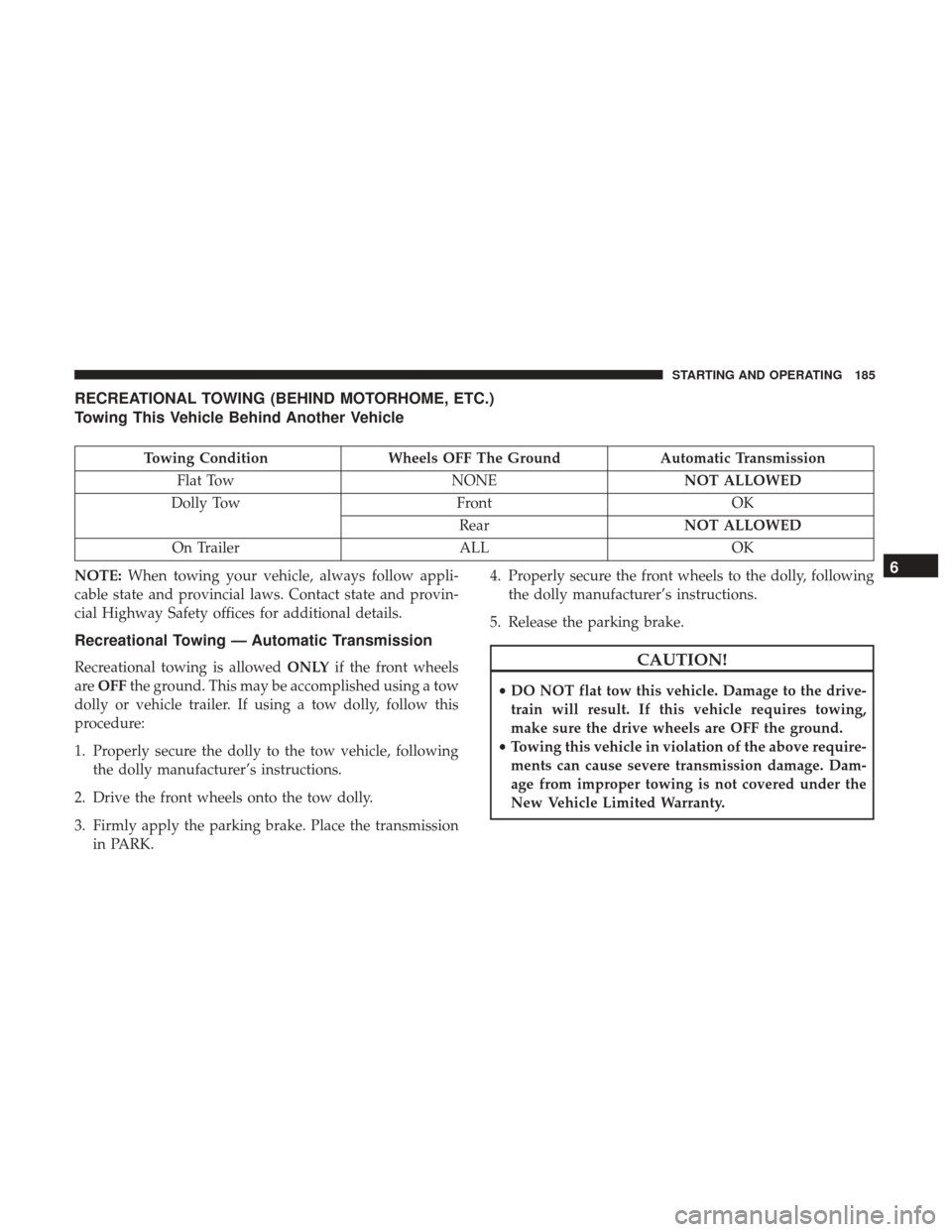
RECREATIONAL TOWING (BEHIND MOTORHOME, ETC.)
Towing This Vehicle Behind Another Vehicle
Towing ConditionWheels OFF The Ground Automatic Transmission
Flat Tow NONENOT ALLOWED
Dolly Tow FrontOK
Rear NOT ALLOWED
On Trailer ALLOK
NOTE: When towing your vehicle, always follow appli-
cable state and provincial laws. Contact state and provin-
cial Highway Safety offices for additional details.
Recreational Towing — Automatic Transmission
Recreational towing is allowed ONLYif the front wheels
are OFF the ground. This may be accomplished using a tow
dolly or vehicle trailer. If using a tow dolly, follow this
procedure:
1. Properly secure the dolly to the tow vehicle, following the dolly manufacturer’s instructions.
2. Drive the front wheels onto the tow dolly.
3. Firmly apply the parking brake. Place the transmission in PARK. 4. Properly secure the front wheels to the dolly, following
the dolly manufacturer’s instructions.
5. Release the parking brake.CAUTION!
• DO NOT flat tow this vehicle. Damage to the drive-
train will result. If this vehicle requires towing,
make sure the drive wheels are OFF the ground.
• Towing this vehicle in violation of the above require-
ments can cause severe transmission damage. Dam-
age from improper towing is not covered under the
New Vehicle Limited Warranty.
6
STARTING AND OPERATING 185
Page 235 of 348

SCHEDULED SERVICING
Your vehicle is equipped with an automatic oil change
indicator system. The oil change indicator system will
remind you that it is time to take your vehicle in for
scheduled maintenance.
Based on engine operation conditions, the oil change
indicator message will illuminate. This means that service
is required for your vehicle. Operating conditions such as
frequent short-trips, trailer tow, extended engine idle time,
extremely hot or cold ambient temperatures will influence
when the “Oil Change Required” message is displayed.
Severe Operating Conditions can cause the change oil
message to illuminate as early as 3,500 miles (5,600 km)
since last reset. Have your vehicle serviced as soon as
possible, within the next 500 miles (805 km).
Your authorized dealer will reset the oil change indicator
message after completing the scheduled oil change. If a
scheduled oil change is performed by someone other than
your authorized dealer, the message can be reset by
referring to the steps described under “Oil Change Reset”
in “Instrument Cluster Display” in “Getting To Know Your
Instrument Panel” for further information.NOTE:
Under no circumstances should oil change inter-
vals exceed 10,000 miles (16,000 km), 350 hours of engine
run time or twelve months, whichever comes first. The 350
hours of engine run or idle time is generally only a concern
for fleet customers.
Severe Duty All Models
Change Engine Oil at 4,000 miles (6,500 km) or 350 hours of
engine run time if the vehicle is operated in a dusty and off
road environment or is operated predominantly at idle, or
only very low engine RPM’s. This type of vehicle use is
considered Severe Duty.
Once A Month Or Before A Long Trip:
• Check engine oil level.
• Check windshield washer fluid level.
• Check tire pressure and look for unusual wear or
damage. Rotate tires at the first sign of irregular wear,
even if it occurs before the oil indicator system turns on.
• Check the fluid levels of the coolant reservoir and brake
master cylinder, fill as needed.
• Check function of all interior and exterior lights.
8
SERVICING AND MAINTENANCE 233
Page 265 of 348
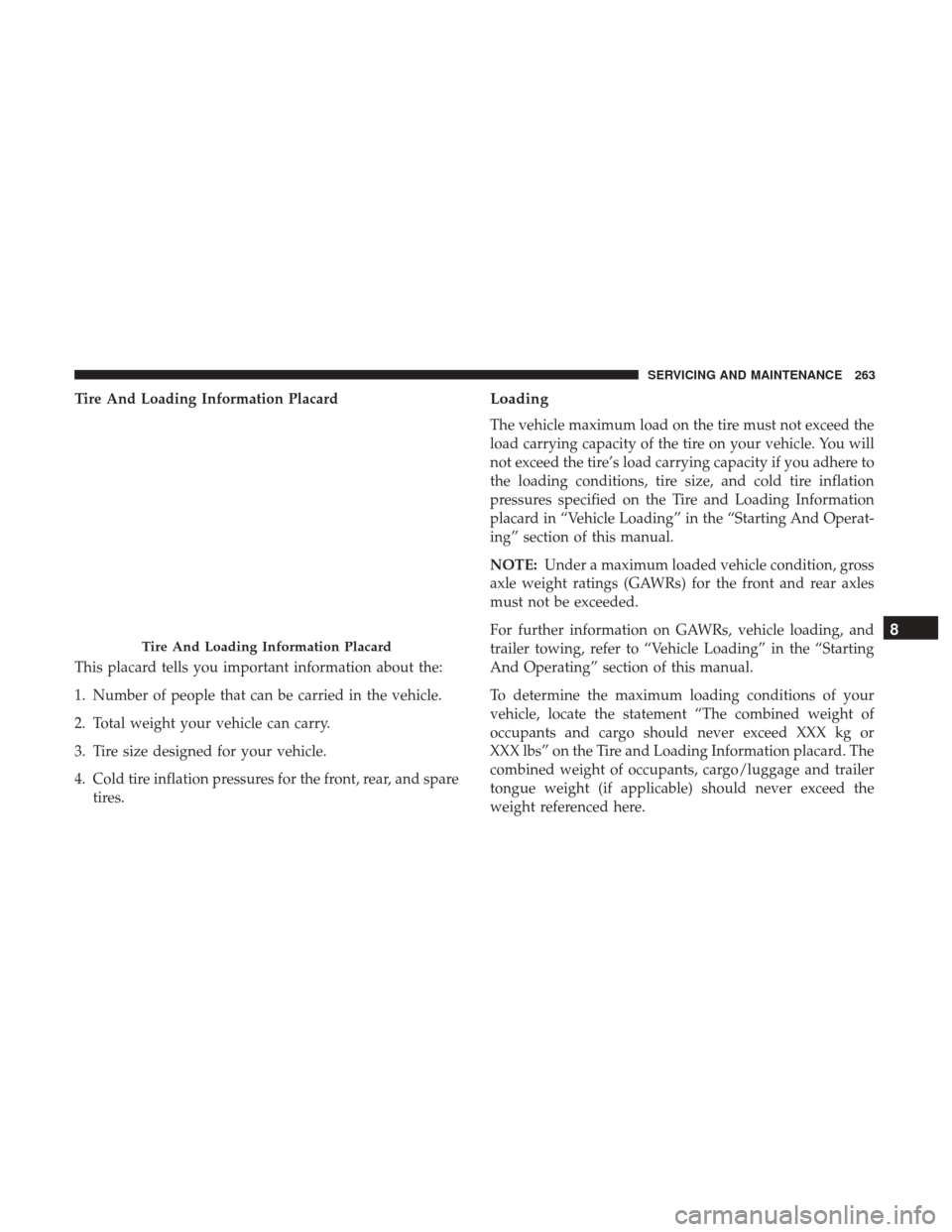
Tire And Loading Information Placard
This placard tells you important information about the:
1. Number of people that can be carried in the vehicle.
2. Total weight your vehicle can carry.
3. Tire size designed for your vehicle.
4. Cold tire inflation pressures for the front, rear, and sparetires.Loading
The vehicle maximum load on the tire must not exceed the
load carrying capacity of the tire on your vehicle. You will
not exceed the tire’s load carrying capacity if you adhere to
the loading conditions, tire size, and cold tire inflation
pressures specified on the Tire and Loading Information
placard in “Vehicle Loading” in the “Starting And Operat-
ing” section of this manual.
NOTE: Under a maximum loaded vehicle condition, gross
axle weight ratings (GAWRs) for the front and rear axles
must not be exceeded.
For further information on GAWRs, vehicle loading, and
trailer towing, refer to “Vehicle Loading” in the “Starting
And Operating” section of this manual.
To determine the maximum loading conditions of your
vehicle, locate the statement “The combined weight of
occupants and cargo should never exceed XXX kg or
XXX lbs” on the Tire and Loading Information placard. The
combined weight of occupants, cargo/luggage and trailer
tongue weight (if applicable) should never exceed the
weight referenced here.
Tire And Loading Information Placard
8
SERVICING AND MAINTENANCE 263
Page 266 of 348
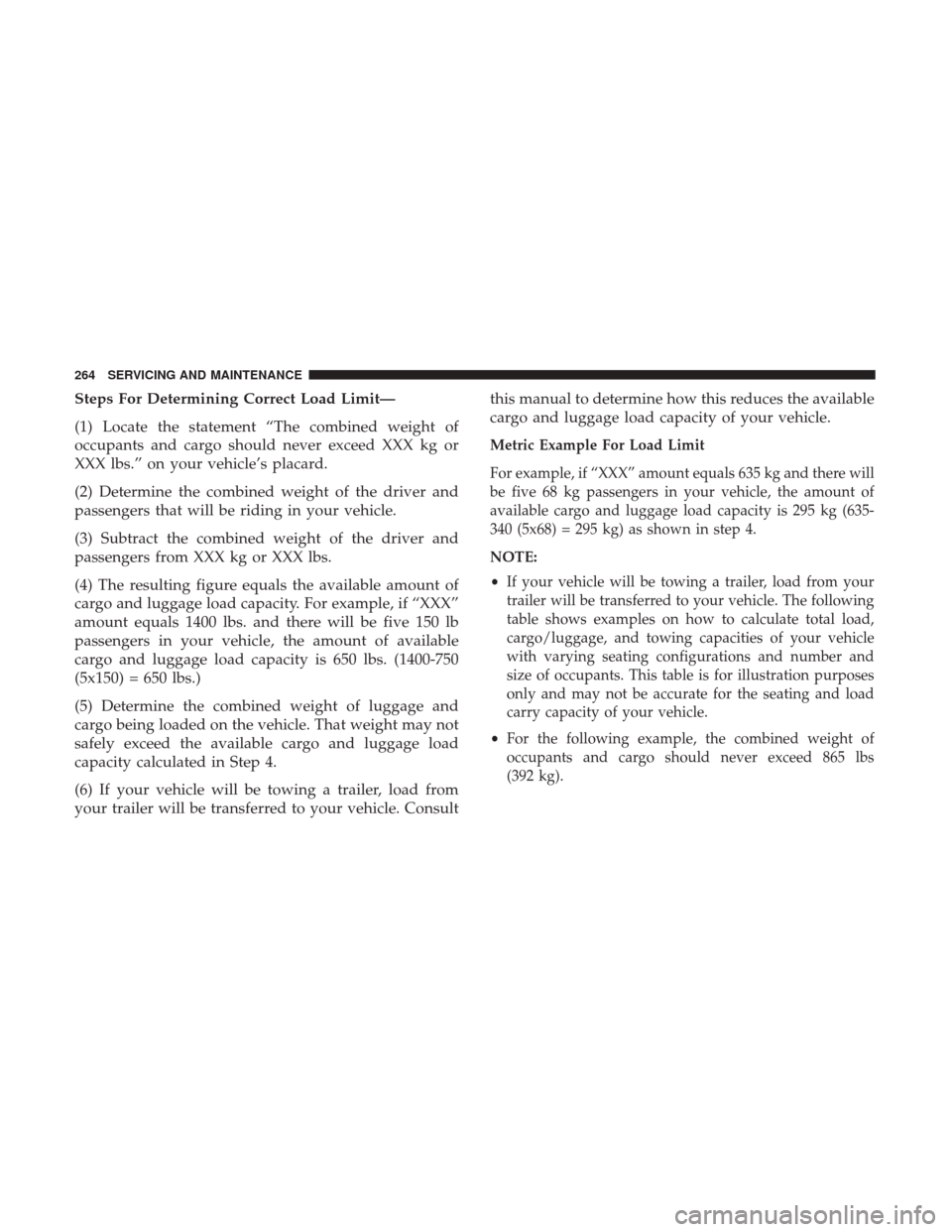
Steps For Determining Correct Load Limit—
(1) Locate the statement “The combined weight of
occupants and cargo should never exceed XXX kg or
XXX lbs.” on your vehicle’s placard.
(2) Determine the combined weight of the driver and
passengers that will be riding in your vehicle.
(3) Subtract the combined weight of the driver and
passengers from XXX kg or XXX lbs.
(4) The resulting figure equals the available amount of
cargo and luggage load capacity. For example, if “XXX”
amount equals 1400 lbs. and there will be five 150 lb
passengers in your vehicle, the amount of available
cargo and luggage load capacity is 650 lbs. (1400-750
(5x150) = 650 lbs.)
(5) Determine the combined weight of luggage and
cargo being loaded on the vehicle. That weight may not
safely exceed the available cargo and luggage load
capacity calculated in Step 4.
(6) If your vehicle will be towing a trailer, load from
your trailer will be transferred to your vehicle. Consultthis manual to determine how this reduces the available
cargo and luggage load capacity of your vehicle.
Metric Example For Load Limit
For example, if “XXX” amount equals 635 kg and there will
be five 68 kg passengers in your vehicle, the amount of
available cargo and luggage load capacity is 295 kg (635-
340 (5x68) = 295 kg) as shown in step 4.
NOTE:
•
If your vehicle will be towing a trailer, load from your
trailer will be transferred to your vehicle. The following
table shows examples on how to calculate total load,
cargo/luggage, and towing capacities of your vehicle
with varying seating configurations and number and
size of occupants. This table is for illustration purposes
only and may not be accurate for the seating and load
carry capacity of your vehicle.
• For the following example, the combined weight of
occupants and cargo should never exceed 865 lbs
(392 kg).
264 SERVICING AND MAINTENANCE
Page 271 of 348

description (Load Index and Speed Symbol). Replace the
tire pressure sensor as well as it is not designed to be
reused.
Run Flat Tires — If Equipped
Run Flat tires allow you the capability to drive 50 miles
(80 km) at 50 mph (80 km/h) after a rapid loss of inflation
pressure. This rapid loss of inflation is referred to as the
Run Flat mode. A Run Flat mode occurs when the tire
inflation pressure is of/or below 14 psi (96 kPa). Once a
Run Flat tire reaches the run flat mode it has limited
driving capabilities and needs to be replaced immediately.
A Run Flat tire is not repairable. When a run flat tire is
changed after driving with underinflated tire condition,
please replace the TPM sensor as it is not designed to be
reused when driven under run flat mode (14 psi (96 kPa))
condition.
NOTE:TPM Sensor must be replaced after driving the
vehicle on a flat tire condition.
It is not recommended driving a vehicle loaded at full
capacity or to tow a trailer while a tire is in the run flat
mode.
See the tire pressure monitoring section for more informa-
tion.
Tire Spinning
When stuck in mud, sand, snow, or ice conditions, do not
spin your vehicle’s wheels above 30 mph (48 km/h) or for
longer than 30 seconds continuously without stopping.
Refer to “Freeing A Stuck Vehicle” in “In Case Of Emer-
gency” for further information.
WARNING!
Fast spinning tires can be dangerous. Forces generated
by excessive wheel speeds may cause tire damage or
failure. A tire could explode and injure someone. Do
not spin your vehicle’s wheels faster than 30 mph
(48 km/h) for more than 30 seconds continuously when
you are stuck, and do not let anyone near a spinning
wheel, no matter what the speed.
Tread Wear Indicators
Tread wear indicators are in the original equipment tires to
help you in determining when your tires should be re-
placed.
8
SERVICING AND MAINTENANCE 269
Page 332 of 348
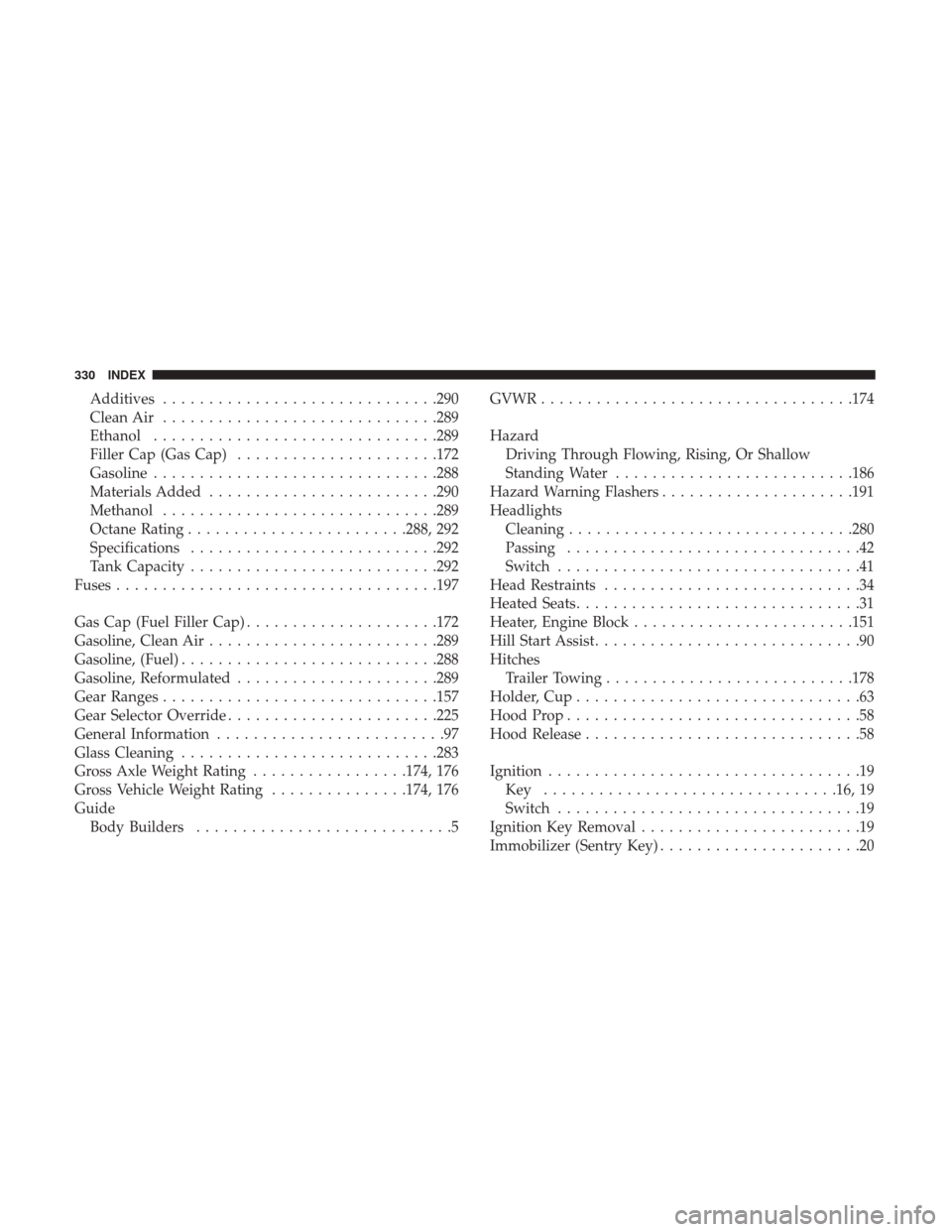
Additives............................. .290
Clean Air ............................. .289
Ethanol .............................. .289
Filler Cap (Gas Cap) ..................... .172
Gasoline .............................. .288
Materials Added ........................ .290
Methanol ............................. .289
Octane Rating ....................... .288, 292
Specifications .......................... .292
Tank Capacity .......................... .292
Fuses .................................. .197
Gas Cap (Fuel Filler Cap) .....................172
Gasoline, Clean Air ........................ .289
Gasoline, (Fuel) ........................... .288
Gasoline, Reformulated ..................... .289
Gear Ranges ............................. .157
Gear Selector Override ...................... .225
General Information .........................97
Glass Cleaning ........................... .283
Gross Axle Weight Rating .................174, 176
Gross Vehicle Weight Rating ...............174, 176
Guide Body Builders ............................5 GVWR
................................. .174
Hazard Driving Through Flowing, Rising, Or Shallow
Standing Water ......................... .186
Hazard Warning Flashers .....................191
Headlights Cleaning .............................. .280
Passing ................................42
Switch .................................41
Head Restraints ............................34
Heated Seats ...............................31
Heater, Engine Block ....................... .151
Hill Start Assist .............................90
Hitches Trailer Towing .......................... .178
Holder, Cup ...............................63
Hood Prop ................................58
Hood Release ..............................58
Ignition ..................................
19
Key ............................... .16, 19
Switch .................................19
Ignition Key Removal ........................19
Immobilizer (Sentry Key) ......................20
330 INDEX
Page 337 of 348
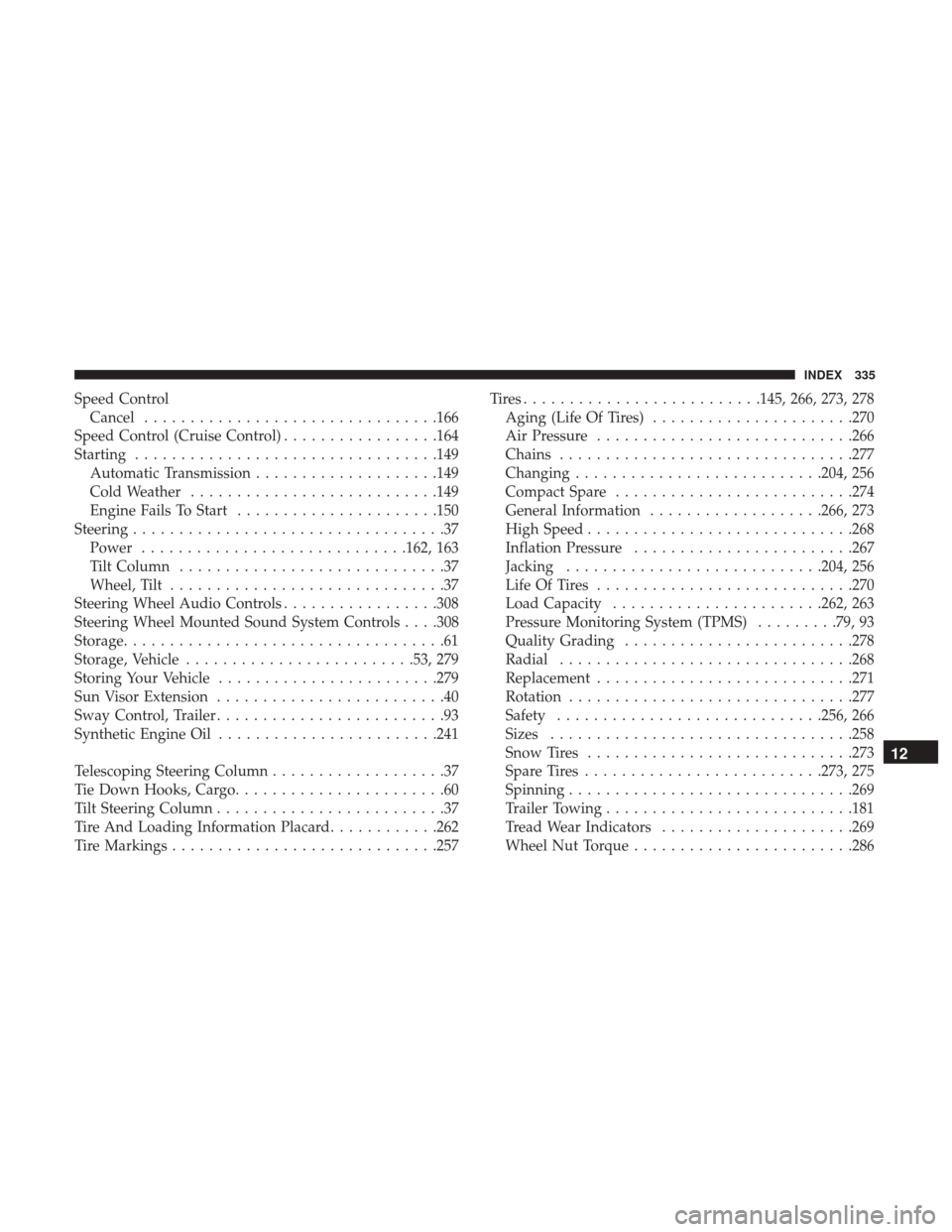
Speed ControlCancel ............................... .166
Speed Control (Cruise Control) .................164
Starting ................................ .149
Automatic Transmission ....................149
Cold Weather .......................... .149
Engine Fails To Start ..................... .150
Steering ..................................37
Power ............................ .162, 163
Tilt Column .............................37
Wheel, Tilt ..............................37
Steering Wheel Audio Controls .................308
Steering Wheel Mounted Sound System Controls . . . .308
Storage ...................................61
Storage, Vehicle ........................ .53, 279
Storing Your Vehicle ....................... .279
Sun Visor Extension .........................40
Sway Control, Trailer .........................93
Synthetic Engine Oil ....................... .241
Telescoping Steering Column ...................37
Tie Down Hooks, Cargo .......................60
Tilt Steering Column .........................37
Tire And Loading Information Placard ............262
Tire Markings ............................ .257Tires.........................
.145, 266, 273, 278
Aging (Life Of Tires) ..................... .270
Air Pressure ........................... .266
Chains ............................... .277
Changing .......................... .204, 256
Compact Spare ......................... .274
General Information ...................266, 273
High Speed ............................ .268
Inflation Pressure ....................... .267
Jacking ........................... .204, 256
Life Of Tires ........................... .270
Load Capacity ...................... .262, 263
Pressure Monitoring System (TPMS) .........79, 93
Quality Grading ........................ .278
Radial ............................... .268
Replacement ........................... .271
Rotation .............................. .277
Safety ............................ .256,
266
Sizes ................................ .258
Snow Tires ............................ .273
Spare Tires ......................... .273, 275
Spinning .............................. .269
Trailer Towing .......................... .181
Tread Wear Indicators .....................269
Wheel Nut Torque ....................... .286
12
INDEX 335
Page 338 of 348
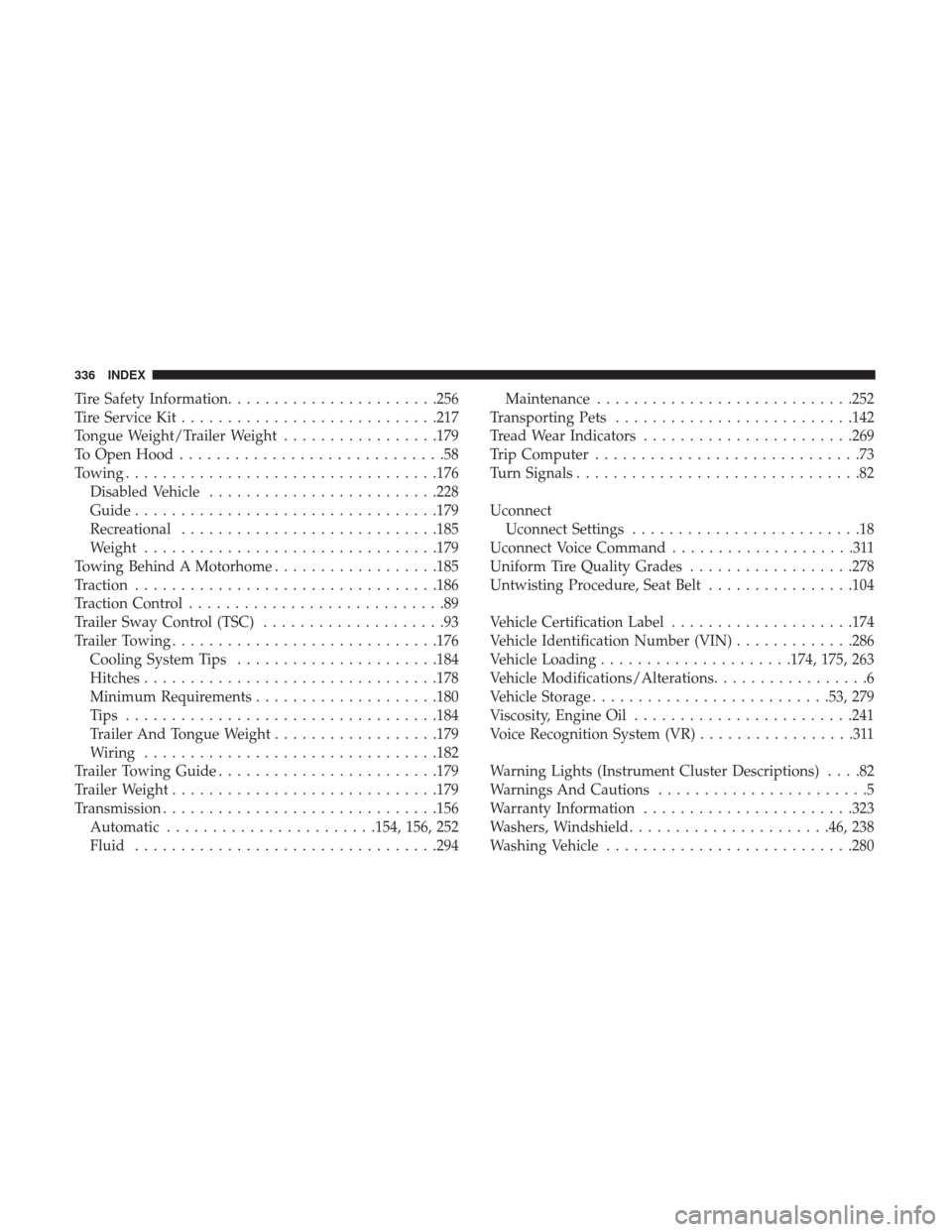
Tire Safety Information...................... .256
Tire Service Kit ........................... .217
Tongue Weight/Trailer Weight .................179
To Open Hood .............................58
Towing ................................. .176
Disabled Vehicle ........................ .228
Guide ................................ .179
Recreational ........................... .185
Weight ............................... .179
Towing Behind A Motorhome ..................185
Traction ................................ .186
Traction Control ............................89
Trailer Sway Control (TSC) ....................93
Trailer Towing ............................ .176
Cooling System Tips ..................... .184
Hitches ............................... .178
Minimum Requirements ....................180
Tips ................................. .184
Trailer And Tongue Weight ..................179
Wiring ............................... .182
Trailer Towing Guide ....................... .179
Trailer Weight ............................ .179
Transmission ............................. .156
Automatic ...................... .154, 156, 252
Fluid ................................ .294Maintenance
........................... .252
Transporting Pets ......................... .142
Tread Wear Indicators ...................... .269
Trip Computer .............................73
Turn Signals ...............................82
Uconnect Uconnect Settings .........................18
Uconnect Voice Command ....................311
Uniform Tire Quality Grades ..................278
Untwisting Procedure, Seat Belt ................104
Vehicle Certification Label ....................174
Vehicle Identification Number (VIN) .............286
Vehicle Loading .....................174,
175, 263
Vehicle Modifications/Alterations .................6
Vehicle Storage ......................... .53, 279
Viscosity, Engine Oil ....................... .241
Voice Recognition System (VR) .................311
Warning Lights (Instrument Cluster Descriptions) ....82
Warnings And Cautions .......................5
Warranty Information ...................... .323
Washers, Windshield ..................... .46, 238
Washing Vehicle .......................... .280
336 INDEX